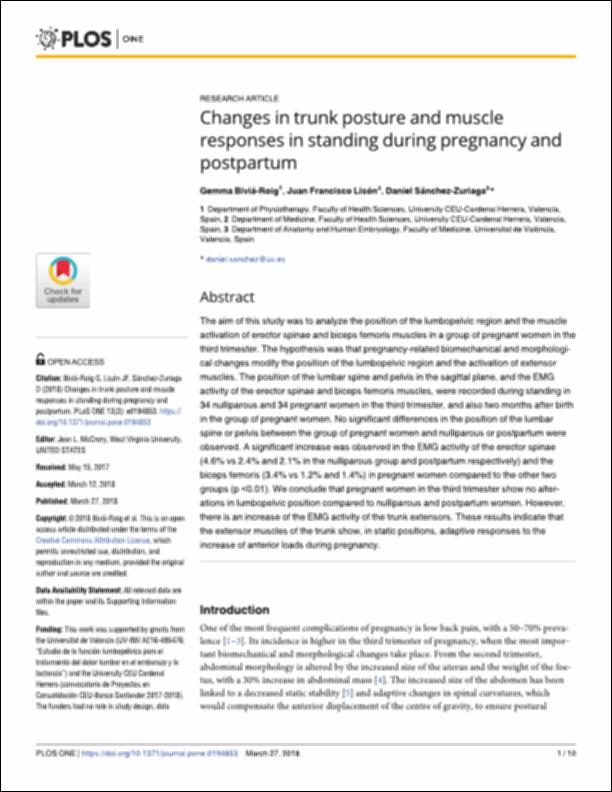Por favor, use este identificador para citar o enlazar este ítem:
http://hdl.handle.net/10637/10528Changes in trunk posture and muscle responses in standing during pregnancy and postpartum
| Título : | Changes in trunk posture and muscle responses in standing during pregnancy and postpartum |
| Autor : | Biviá Roig, Gemma Lisón Párraga, Juan Francisco Sánchez Zuriaga, Daniel |
| Materias: | Dolor pélvico.; Columna vertebral - Músculos.; Lumbago.; Embarazo - Complicaciones y secuelas.; Pregnancy - Complications.; Dolor de espalda.; Backache.; Columna vertebral - Anomalías y malformaciones.; Spine - Abnormalities.; Pelvis - Propiedades mecánicas.; Columna vertebral - Propiedades mecánicas.; Spine - Muscles.; Pelvis - Muscles.; Spine - Mechanical properties.; Pelvis - Mechanical properties.; Pelvis - Músculos.; Mujeres embarazadas.; Pregnant women.; Pelvic pain. |
| Editorial : | PLOS. |
| Citación : | Biviá Roig, G., Lisón Párraga, JF. and Sánchez Zuriaga, D. (2018). Changes in trunk posture and muscle responses in standing during pregnancy and postpartum. Plos One, vol. 13, n. 3, art. e0194853. DOI: https://doi.org/10.1371/journal.pone.0194853 |
| Resumen : | The aim of this study was to analyze the position of the lumbopelvic region and the muscle activation of erector spinae and biceps femoris muscles in a group of pregnant women in the third trimester. The hypothesis was that pregnancy-related biomechanical and morphological changes modify the position of the lumbopelvic region and the activation of extensor muscles. The position of the lumbar spine and pelvis in the sagittal plane, and the EMG activity of the erector spinae and biceps femoris muscles, were recorded during standing in 34 nulliparous and 34 pregnant women in the third trimester, and also two months after birth in the group of pregnant women. No significant differences in the position of the lumbar spine or pelvis between the group of pregnant women and nulliparous or postpartum were observed. A significant increase was observed in the EMG activity of the erector spinae (4.6% vs 2.4% and 2.1% in the nulliparous group and postpartum respectively) and the biceps femoris (3.4% vs 1.2% and 1.4%) in pregnant women compared to the other two groups (p <0.01). We conclude that pregnant women in the third trimester show no alterations in lumbopelvic position compared to nulliparous and postpartum women. However, there is an increase of the EMG activity of the trunk extensors. These results indicate that the extensor muscles of the trunk show, in static positions, adaptive responses to the increase of anterior loads during pregnancy. |
| Descripción : | Este artículo se encuentra disponible en la página web de la revista en la siguiente URL: https://journals.plos.org/plosone/article?id=10.1371/journal.pone.0194853 |
| URI : | http://hdl.handle.net/10637/10528 |
| Derechos: | http://creativecommons.org/licenses/by/4.0/deed.es |
| ISSN : | 1932-6203. |
| Fecha de publicación : | 27-mar-2018 |
| Centro : | Universidad Cardenal Herrera-CEU |
| Aparece en las colecciones: | Dpto. Enfermería y Fisioterapia |
Los ítems de DSpace están protegidos por copyright, con todos los derechos reservados, a menos que se indique lo contrario.


